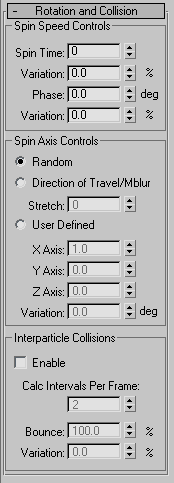Particles often move at high rates of speed. In such cases, you might want to add motion blur to the particles to enhance their motion. Also, real-world particles typically rotate as they move, and collide with each other.
The options on this rollout affect the rotation of the particles, provide motion blur effects, and control inter-particle collisions.
Interface

Spin Speed Controls group
- Spin Time
- The number of frames for one rotation of a particle. If set to 0, no rotation takes place.
- Variation
- The percent of variation of the Spin Time.
- Phase
- Sets the initial particle rotation, in degrees. This has no meaning for fragments, which always begin with zero rotation.
- Variation
- The percent of variation of the Phase.
Spin Axis Controls group
These options determine the spin axis for the particles, and provide a partial method of applying motion blur to the particles.
- Random The spin axis for each of the particles is random.
-
Direction of Travel/Mblur
(Not available with the Blizzard particle system.) Rotates the particles about a vector formed by the direction in which they're moving. This option also lets you apply a form of motion blur to the particles by using the Stretch spinner. For further information, see Achieving Particle Motion Blur.
Stretch When greater than 0, the particles stretch along the travel axis, depending on their speed. Specifically, the Stretch value specifies the percent of their length per each unit of the Speed setting (in the Particle Motion group). Thus, if you set Stretch to 2 while Speed is set at 10, the particles are stretched 20 percent longer than their original size along the axis of their travel. This spinner is available only when you choose Direction of Travel/Mblur.
Note: For best results when using Stretch, you should also assign the Particle MBlur map as an opacity map of the material assigned to the particle system. -
User Defined
Uses a vector defined in the three X, Y, and Z axis spinners.
X/Y/Z Axis Specifies the spin vector of the X, Y, or Z axis, respectively. These spinners are available only when User Defined is chosen.
Variation The amount, in degrees, by which the spin axis of each particle may vary from the specified X Axis, Y Axis, and Z Axis settings. This spinner is available only when you choose User Defined.
Interparticle Collisions group
These options enable collisions between particles, and control how the collisions occur. Note that this involves intensive calculation, particularly when large numbers of particles are involved.
- Enable
- Enables inter-particle collisions in the calculation of the particle movements.
- Calc Intervals Per Frame
- The number of intervals per rendering interval, during which an inter-particle collision test is conducted. The higher the value, the more accurate the simulation, but the slower the simulation will run.
- Bounce
- The degree to which speed is recovered after a collision.
- Variation
- The percentage of random variation of the Bounce value, applied to the particles.